1
Fill in the blank. A(n) ________________ is a semicircular niche in the wall of a mosque that indicates the direction that Muslims should face when praying.
Choose one answer.
|
A. Mihrab |
||
|
B. Minaret |
||
|
C. Iwan |
||
|
D. Muqarna |
||
|
E. Madrasa |
Question 2
Elements from which of the following artistic traditions were adopted in early Islamic art and architecture?
Choose one answer.
|
A. Byzantine |
||
|
B. Sassanian |
||
|
C. Greco-Roman |
||
|
D. All of the above |
||
|
E. None of the above |
Question 3
Who built the Alhambra?
Choose one answer.
|
A. The Nasirids |
||
|
B. The Abbasids |
||
|
C. The Seljuks |
||
|
D. The Fatimids |
||
|
E. The Umayyads |
Question 4
Fill in the blank. The gardens of wealthy Islamic patrons were often designed based on descriptions of ________________.
Choose one answer.
|
A. Islamic paradise |
||
|
B. Mecca |
||
|
C. Medina |
||
|
D. All of the above |
||
|
E. None of the above |
Question 5
Fill in the blank. The _________________ are famous for building palaces that are often referred to as "desert castles."
Choose one answer.
|
A. Umayyads |
||
|
B. Ottomans |
||
|
C. Abbasids |
||
|
D. Ayyubids |
||
|
E. Fatimids |
Question 6
Which of the following is best described as a cube-like brick structure covered in a black cloth embroidered with verses from the Koran that is the focus of Islamic pilgrimage?
Choose one answer.
|
A. Ka'ba |
||
|
B. Dome of the Rock |
||
|
C. Kiswa |
||
|
D. Madrasa |
||
|
E. None of the above |
Question 7
Which of the following is the oldest extant example of Islamic architecture and was constructed by the Umayyad Caliphate?
Choose one answer.
|
A. Dome of the Rock |
||
|
B. Ka'ba |
||
|
C. Great Mosque of Damascus |
||
|
D. Great Mosque of Córdoba |
||
|
E. Sulaybiya Mausoleum |
Question 8
This image depicts the Courtyard of Lions, part of what large palace complex?
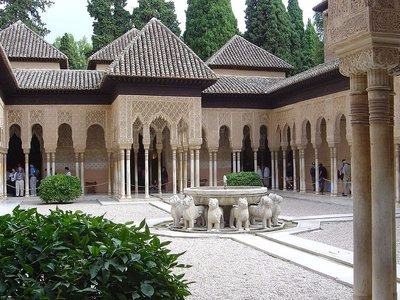
Choose one answer.
|
A. The Alhambra |
||
|
B. The Red Fort |
||
|
C. The Topkapi Palace |
||
|
D. Qusayr 'Amra |
||
|
E. Guri Amir |
Question 9
Fill in the blank. This image depicts the prayer hall of _______________. Its arches are made of alternating red and white wedge-shaped blocks that are associated with Umayyad monuments, such as the Umayyad Mosque and the Dome of the Rock.
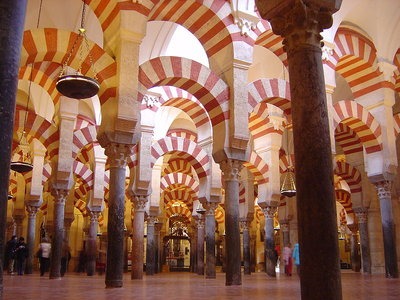
Choose one answer.
|
A. The Sultan Hasan Mosque |
||
|
B. The Great Mosque of Córdoba |
||
|
C. The Al-Aqsa Mosque |
||
|
D. The Süleymaniye Mosque |
||
|
E. Qusayr 'Amra |
Question 10
Fill in the blank. This image depicts _____________, the first monumental building project in Islamic history.
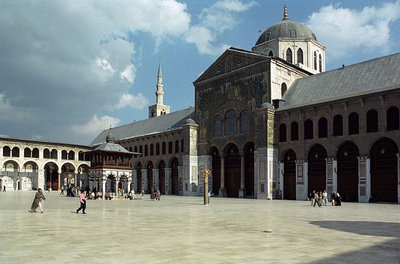
Choose one answer.
|
A. The Dome of the Rock |
||
|
B. The Umayyad Mosque |
||
|
C. The Al-Aqsa Mosque |
||
|
D. Great Mosque of Córdoba |
||
|
E. Qusayr 'Amra |
Question 11
This image shows the courtyard of which structure? The floor of the courtyard is made of marble and its arcades are decorated with gold mosaics.
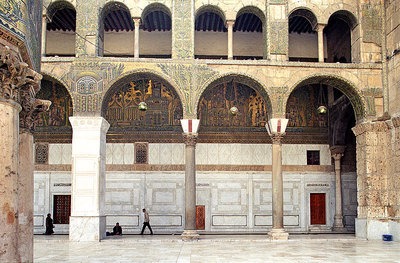
Choose one answer.
|
A. The Umayyad Mosque |
||
|
B. The Sultan Hasan Mosque |
||
|
C. The Taj Mahal |
||
|
D. The Süleymaniye Mosque |
||
|
E. Maidan-I Shah |
Question 12
This image shows the honeycomb-like vaulted ceiling of the Hall of the Abencerrajes in which of the following buildings?
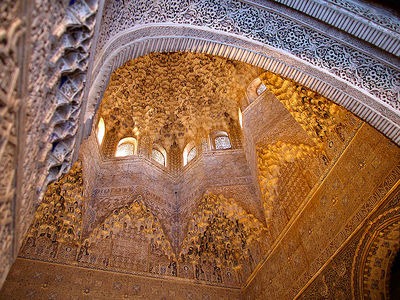
Choose one answer.
|
A. The Great Mosque of Córdoba |
||
|
B. The Alhambra |
||
|
C. The Great Mosque of Damascus |
||
|
D. The Süleymaniye Mosque |
||
|
E. The Sultan Hasan Mosque |
Question 13
This picture shows what important Islamic shrine that covers the site where Muhammad was said to have ascended into the sky with the Angel Gabriel?
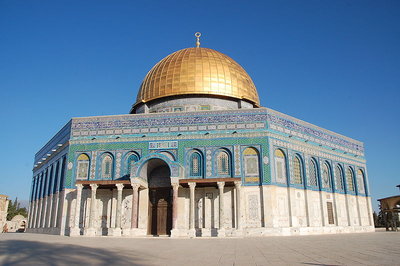
Choose one answer.
|
A. The Dome of the Rock |
||
|
B. The Qibla |
||
|
C. The Ka'ba |
||
|
D. The Great Mosque of Damascus |
||
|
E. The Sultan Hasan Mosque |
Question 14
When praying, Muslims face in the direction of which of the following?
Choose one answer.
|
A. The Ka'ba in Mecca |
||
|
B. The Dome of the Rock in Jerusalem |
||
|
C. The House of the Prophet in Medina |
||
|
D. All of the above |
||
|
E. None of the above |
Question 15
Which of the following is part of the Five Pillars of Islam?
Choose one answer.
|
A. Profession of Faith |
||
|
B. Fasting |
||
|
C. Alms |
||
|
D. Prayer |
||
|
E. All of the above |
Question 16
Which of the following is the earliest style of Arabic calligraphy?
Choose one answer.
|
A. Kufic |
||
|
B. Naskhi |
||
|
C. Thuluth |
||
|
D. Nastaʿlīq |
||
|
E. Ruq'ah |
Question 17
Which of the following statements about the Hajj is false?
Choose one answer.
|
A. It is an optional part of the Muslim faith. |
||
|
B. All Muslims, if financially and physically able, must perform it once in their lifetime. |
||
|
C. It is performed during the twelfth month of the Islamic calendar. |
||
|
D. Pilgrims wear simple clothes made of two pieces of unstitched white cloth. |
||
|
E. Its focus is on the Ka'ba in Mecca. |
Question 18
Which of the following statements about mosques are true?
Choose one answer.
|
A. A large architectural space for prayer is central to a mosque's design. |
||
|
B. Historically, in addition to being places for prayer, mosques were community meeting places. |
||
|
C. The very first mosque was believed to be in the courtyard of Muhammad's home. |
||
|
D. All of the above |
||
|
E. None of the above |
Question 19
Which of the following structures are located in Haram Al-Sharif?
Choose one answer.
|
A. The Ka'ba |
||
|
B. The Al-Aqsa Mosque |
||
|
C. The Great Mosque of Damascus |
||
|
D. The Sultan Hasan Mosque |
||
|
E. Qusayr 'Amra |
Question 20
Which of the following would you NOT find decorating a mosque?
Choose one answer.
|
A. Vegetal scrolls |
||
|
B. Calligraphy |
||
|
C. Figural decoration |
||
|
D. Floral motifs |
||
|
E. Geometric patterns |
Question 21
Which of the following is a style of Spanish art and architecture produced in the 12th to 16th centuries that combines Islamic and Romanesque, Gothic, or Renaissance architectural elements and decorative motifs?
Choose one answer.
|
A. Mudėjar |
||
|
B. Kufic |
||
|
C. Mashriq |
||
|
D. Maghreb |
||
|
E. Nasrid |
Question 22
Which of the following can best be described as tall towers from which the call to prayer is often made?
Choose one answer.
|
A. Minarets |
||
|
B. Madrasas |
||
|
C. Iwans |
||
|
D. Mihrabs |
||
|
E. Maqsurahs |
Question 23
Which of the following refers to Islamic religious laws and customs that govern every aspect of a Muslim’s life?
Choose one answer.
|
A. Sha'ria |
||
|
B. Hadith |
||
|
C. Qibla |
||
|
D. Umma |
||
|
E. Ramadan |
Question 24
What was the capital of the Umayyad dynasty?
Choose one answer.
|
A. Damascus |
||
|
B. Jerusalem |
||
|
C. Cairo |
||
|
D. Istanbul |
||
|
E. Ishafan |
Question 25
Art produced during which of the following periods combines elements of Islamic, Persian, and Central Asian-Turkic artistic traditions?
Choose one answer.
|
A. The Umayyad period |
||
|
B. The Abbasid period |
||
|
C. The Seljuk period |
||
|
D. The Mamluk period |
||
|
E. The Fatimid period |
Question 26
Inlaid bronze and brass objects decorated with Arabic script in which letters were transformed into human and animal figures are associated with which time period?
Choose one answer.
|
A. The Umayyad period |
||
|
B. The Abbasid period |
||
|
C. The Seljuk period |
||
|
D. The Ilkhanid period |
||
|
E. The Fatimid period |
Question 27
The introduction of luster painting over a white glaze is associated with which time period?
Choose one answer.
|
A. The Umayyad period |
||
|
B. The Abbasid period |
||
|
C. The Seljuk period |
||
|
D. The Fatimid period |
||
|
E. The Ottoman period |
Question 28
The mud-brick mausoleum of Sultan Sanjar occupies the center of the ruined city wall of Merv, the capital of which dynasty?
Choose one answer.
|
A. Umayyad |
||
|
B. Abbasid |
||
|
C. Seljuk |
||
|
D. Fatimid |
||
|
E. Timurid |
Question 29
The tomb tower and the square domed mausoleum are the two types of funerary architecture most associated with what dynasty?
Choose one answer.
|
A. Umayyad |
||
|
B. Abbasid |
||
|
C. Seljuk |
||
|
D. Ottoman |
||
|
E. Mughal |
Question 30
The tradition of building royal mausoleums was introduced to the Islamic world during which time period?
Choose one answer.
|
A. The Umayyad period |
||
|
B. The Abbasid period |
||
|
C. The Fatimid period |
||
|
D. The Ilkhanid period |
||
|
E. The Ottoman period |
Question 31
This image depicts the minaret of which mosque built by one of the rulers of the Abbasid caliphate?
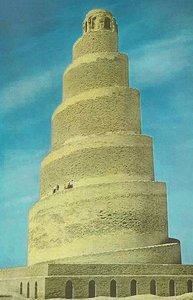
Choose one answer.
|
A. The Great Mosque of Córdoba |
||
|
B. The Sultan Hasan Mosque |
||
|
C. The Great Mosque of Al-Mutawakkil |
||
|
D. The Süleymaniye Mosque |
||
|
E. The Ka'ba |
Question 32
What city briefly served as the capital of the Abbasid caliphate from 833-883 and is an important source of information about Abbasid art and architecture?
Choose one answer.
|
A. Samarra |
||
|
B. Damascus |
||
|
C. Baghdad |
||
|
D. Istanbul |
||
|
E. Cairo |
Question 33
Fill in the blank. When compared to earlier Islamic art and architecture, which was based on Hellenistic/Late Roman forms, _______________ architecture shows a new monumental style that included elements of earlier Sassanian architecture and massive brick piers and arches.
Choose one answer.
|
A. Umayyad |
||
|
B. Abbasid |
||
|
C. Mamluk |
||
|
D. Ottoman |
||
|
E. Mughal |
Question 34
Which of the following is the Iranian term for a portal that projects over the facade of a building?
Choose one answer.
|
A. Pishtaq |
||
|
B. Iwan |
||
|
C. Muqarna |
||
|
D. Masjid |
||
|
E. Mihrab |
Question 35
Which of the following mosques, located in Fez, Morocco, is the largest mosque in Africa as well as one of the world's oldest universities?
Choose one answer.
|
A. The Qarawiyyin Mosque |
||
|
B. The Sultan Hasan Mosque |
||
|
C. The Al-Aqsa Mosque |
||
|
D. The Alhambra |
||
|
E. The Umayyad Mosque |
Question 36
Which of the following were built along important trade routes by Islamic rulers and wealthy patrons to provide protection and lodgings to travelers?
Choose one answer.
|
A. Caravanserais |
||
|
B. Muqarnas |
||
|
C. Iwans |
||
|
D. Pishtaqs |
||
|
E. Madrasas |
_____ were built along important trade routes by Islamic rulers and wealthy patrons to provide protection and lodgings to travelers.
Question 37
Fill in the blank. The circular City of Peace, _______________, was the capital of the Abbasid caliphate.
Choose one answer.
|
A. Baghdad |
||
|
B. Jerusalem |
||
|
C. Medina |
||
|
D. Cairo |
||
|
E. Istanbul |
Question 38
Fill in the blank. Vaulted halls that are walled on three sides, known as ________________, became one of the basic units of the Islamic architecture during the Seljuk period.
Choose one answer.
|
A. Caravanserais |
||
|
B. Iwan |
||
|
C. Muqarna |
||
|
D. Mihrab |
||
|
E. Madrasa |
Question 39
Architecture built under which of the following dynasties was made primarily of stone but included doors, panels, mihrabs, and lattice-work screens that were made of wood?
Choose one answer.
|
A. The Umayyad dynasty |
||
|
B. The Ayyubid dynasty |
||
|
C. The Mamluk dynasty |
||
|
D. The Ilkhanid dynasty |
||
|
E. The Timurid dynasty |
Question 40
City planning under which of the following rulers centered on the palace of the ruler rather than a central mosque?
Choose one answer.
|
A. The Umayyads |
||
|
B. The Abbasids |
||
|
C. The Seljuks |
||
|
D. The Fatimids |
||
|
E. The Ottomans |
Question 41
Enameled glass lamps, such as the piece you see here, are associated with which of the following dynasties?
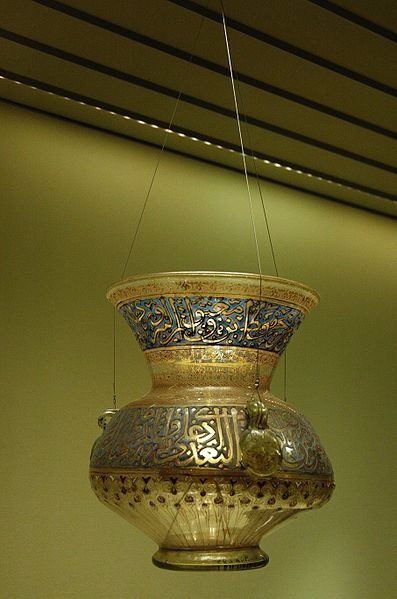
Choose one answer.
|
A. The Ilkhanid dynasty |
||
|
B. The Ottoman dynasty |
||
|
C. The Seljuk dynasty |
||
|
D. The Mamluk dynasty |
||
|
E. The Mughal dynasty |
Question 42
Mosques built by which of the following rulers are distinctive because of their absence of minarets?
Choose one answer.
|
A. The Umayyads |
||
|
B. The Abbasids |
||
|
C. The Fatimids |
||
|
D. The Seljuks |
||
|
E. The Ottomans |
Question 43
This image depicts which mosque built by the Mamluks that is part of a complex that includes the mosque, a madrasa, and a mausoleum?
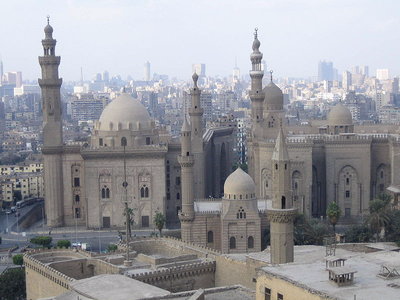
Choose one answer.
|
A. The Great Mosque of Córdoba |
||
|
B. The Sultan Hasan Mosque |
||
|
C. The Al-Aqsa Mosque |
||
|
D. The Süleymaniye Mosque |
||
|
E. The Al-Hakim Mosque |
Question 44
This image depicts which of the following mosques that was first built by the Fatimids and later became the largest Sunni university in the world?
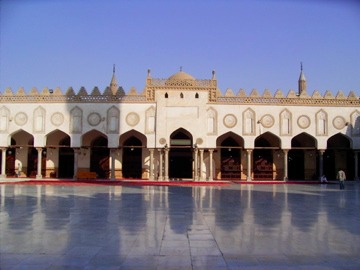
Choose one answer.
|
A. The Al-Azhar Mosque |
||
|
B. The Umayyad Mosque |
||
|
C. The Al-Aqsa Mosque |
||
|
D. The Süleymaniye Mosque |
||
|
E. The Sultan Hasan Mosque |
Question 45
This image depicts which of the following structures built by the Ayyubid ruler Saladin?
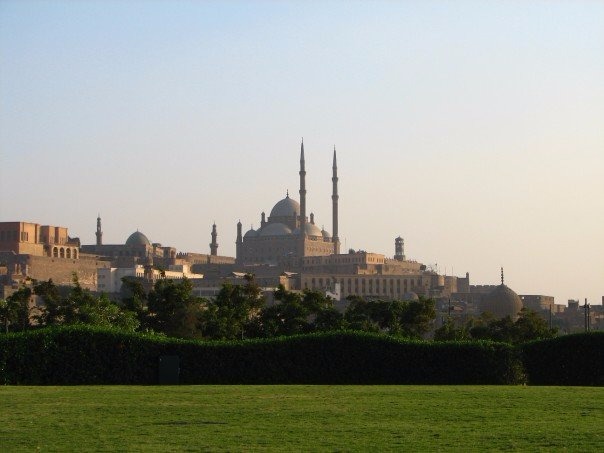
Choose one answer.
|
A. The Citadel of Cairo |
||
|
B. The Sultan Hasan Mosque |
||
|
C. The Firdawsi Mosque and Madrasa |
||
|
D. The Süleymaniye Mosque |
||
|
E. The Imam al-Shafi'i Mausoleum |
Question 46
Tiraz textiles are associated with which of the following dynasties?
Choose one answer.
|
A. The Umayyads |
||
|
B. The Mamluks |
||
|
C. The Fatimids |
||
|
D. The Mughals |
||
|
E. The Safavids |
Question 47
Which of the following is characteristic of Mamluk architecture?
Choose one answer.
|
A. The four iwan plan |
||
|
B. Three-tiered minarets |
||
|
C. Domes with cylindrical drums and pointed profiles |
||
|
D. Stone muqarnas |
||
|
E. All of the above |
Question 48
Which dynasty focused most of its patronage on constructing madrasas, some of which housed several Sunni schools that were organized around a central courtyard?
Choose one answer.
|
A. The Umayyad dynasty |
||
|
B. The Abbasid dynasty |
||
|
C. The Ayyubid dynasty |
||
|
D. The Fatimid dynasty |
||
|
E. The Mughal dynasty |
Question 49
Art and architecture of which period was a fusion of Persian, Islamic, and East Asian traditions?
Choose one answer.
|
A. The Ilkhanid period |
||
|
B. The Abbasid period |
||
|
C. The Seljuk period |
||
|
D. The Mamluk period |
||
|
E. The Umayyad period |
Question 50
The apogee of Ilkhanid illustrated manuscripts is said to be which of the following?
Choose one answer.
|
A. The Great Mongol Shahnama |
||
|
B. The Book of Omens |
||
|
C. The Free Men's Companion to the Subtleties of Poetry |
||
|
D. The Compendium of Chronicles |
||
|
E. History of the World Conqueror |
Question 51
The interior and the exterior of which of the following Ilkhanid buildings was originally covered with brilliantly colored ceramic tiles?
Choose one answer.
|
A. The Great Mosque of Córdoba |
||
|
B. The Sultan Hasan Mosque |
||
|
C. The Takht-i Sulayman Summer Palace |
||
|
D. The Süleymaniye Mosque |
||
|
E. The Imam al-Shafi'i Mausoleum |
Question 52
The Oljeitu Tomb is all that remains of which of the following cities that was the capital of the Ilkhanids?
Choose one answer.
|
A. Sultaniya |
||
|
B. Fez |
||
|
C. Merv |
||
|
D. Samarra |
||
|
E. Fatehpur Sikri |
Question 53
This image depicts the dome of which mosque that was built by Timur in Samarkand after his conquest of Hindustan?
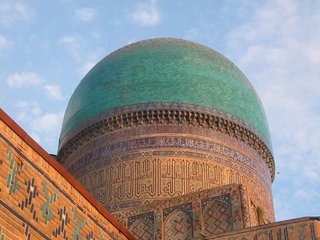
Choose one answer.
|
A. The Bibi Khanum Mosque |
||
|
B. The Sultan Hasan Mosque |
||
|
C. The Al-Aqsa Mosque |
||
|
D. The Süleymaniye Mosque |
||
|
E. The Moti Mosque |
Question 54
Timur and his sons are buried at what site in Samarkand?
Choose one answer.
|
A. Guri Amir |
||
|
B. The Amir Burunduq Mausoleum |
||
|
C. Aq Saray Mausoleum |
||
|
D. The Bibi Khanum Mosque |
||
|
E. The Ishrat Khana Tomb |
Question 55
Which of the following statements about the text and illustrations of the Shahnama or Persian Book of Kings is false?
Choose one answer.
|
A. Elaborate illustrations of the Shahnama were commissioned to legitimize rulers. |
||
|
B. The Shahnama tells the history of Persia up until the conquest of Alexander the Great. |
||
|
C. The two most famous copies are the Great Mongol Shahnama and the Shah Tahmasp Shahnama. |
||
|
D. Illustrations usually depicted past real and mythical rulers dressed in contemporary costume. |
||
|
E. Copies of the Shahnama were compilations of the artwork of painters, calligraphers, and other craftsmen. |
Question 56
Which of the following statements about Timurid architecture is false?
Choose one answer.
|
A. It combines Persian and Central Asian elements. |
||
|
B. It can be divided into four time periods based on the reigns of different rulers. |
||
|
C. Its technique of squinch-net vaulting was developed in Herat. |
||
|
D. Few Timurid architectural features were incorporated into later Safavid, Ottoman, or Mughal architecture. |
||
|
E. Timurid rulers built madrasa-khanaqh complexes. |
Question 57
Which of the following was the major design innovation of the Bibi Khanum Mosque?
Choose one answer.
|
A. It had dome chambers beyond its lateral iwans. |
||
|
B. It followed a four iwan plan. |
||
|
C. It was the first square dome mosque. |
||
|
D. It used cantilinear vaults. |
||
|
E. All of the above |
Question 58
Which of the following was an artistic and cultural center of the Timurid Empire?
Choose one answer.
|
A. Herat |
||
|
B. Samarkand |
||
|
C. Bukhara |
||
|
D. Shahr-i Sabz |
||
|
E. All of the above |
Question 59
Pictorial space as well as motifs, such as the peony, cloud bands, dragons, and phoenixes, from which culture were incorporated into Ilkhanid period art?
Choose one answer.
|
A. Chinese |
||
|
B. Egyptian |
||
|
C. Russian |
||
|
D. All of the above |
||
|
E. None of the above |
Question 60
Ceramics produced in which of the following modern countries were highly valued and inspired artistic developments in the Safavid, Ottoman, and Mughal empires?
Choose one answer.
|
A. China |
||
|
B. Italy |
||
|
C. Russia |
||
|
D. England |
||
|
E. Korea |
Question 61
Developments in Safavid architecture and city planning are best known by Shah Abbas I's building projects in what city?
Choose one answer.
|
A. Damascus |
||
|
B. Ishafan |
||
|
C. Samarkand |
||
|
D. Baghdad |
||
|
E. Samarra |
Question 62
Hindu architectural forms were used in the building of which early Indian mosque, part of which is depicted in this picture?
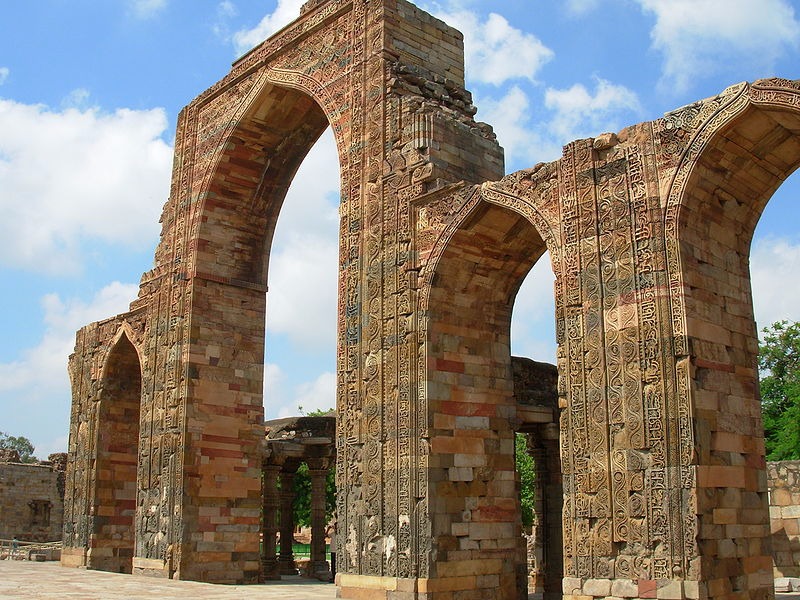
Choose one answer.
|
A. The Quwwat al-Islam Mosque |
||
|
B. The Moti Masjid |
||
|
C. The Jama Masjid of Dehli |
||
|
D. The Mecca Masjid |
||
|
E. The Atala Masjid |
Question 63
Ishafan was the capital of which two Islamic dynasties?
Choose one answer.
|
A. Seljuk and Safavid |
||
|
B. Seljuk and Timurid |
||
|
C. Fatimid and Mamluk |
||
|
D. Ummayad and Abbasid |
||
|
E. Abbasid and Seljuk |
Question 64
Riza 'Abbasi is credited with bringing a new set of subject matter to Persian painting that included which of the following?
Choose one answer.
|
A. Semi-nude figures |
||
|
B. Languid youths |
||
|
C. Young lovers |
||
|
D. All of the above |
||
|
E. None of the above |
Question 65
The buildings of Fatehpur Sikri are made from what kind of stone?
Choose one answer.
|
A. Limestone |
||
|
B. Red sandstone |
||
|
C. White marble |
||
|
D. All of the above |
||
|
E. None of the above |
Question 66
The city of Fatehpur Sikri was founded by which Mughal emperor?
Choose one answer.
|
A. Humayun |
||
|
B. Shah Jahan |
||
|
C. Akbar |
||
|
D. Salim Christi |
||
|
E. Jahangir |
Question 67
The Ottoman ruler Mehmed II, "The Conqueror," drew on elements of which of the following traditions in his rebuilding programs at Istanbul?
Choose one answer.
|
A. Byzantine |
||
|
B. Turkic |
||
|
C. Perseo-Islamic |
||
|
D. European |
||
|
E. All of the above |
Question 68
Fill in the blank. The Ottoman Sultan Ahmed III's reign is also known as the _____________ period, due to the popularity of this flower in floral decorations that replaced the saz style of ornamentation.
Choose one answer.
|
A. Tulip |
||
|
B. Rose |
||
|
C. Peony |
||
|
D. Gardenia |
||
|
E. Iris |
Question 69
The reign of which of the following Ottoman rulers is usually considered to be the "Golden Age" of the Ottoman Empire?
Choose one answer.
|
A. Mahmud II |
||
|
B. Osman I |
||
|
C. Mehmed II |
||
|
D. Suleiman the Magnificent |
||
|
E. Selim I |
Question 70
The Safavid rulers are famous for their patronage of which of the following arts?
Choose one answer.
|
A. Illustrated manuscripts |
||
|
B. Inlaid metalwork |
||
|
C. Enameled glass |
||
|
D. Blown glass |
||
|
E. Luster painted ceramics |
Question 71
The Taj Mahal is made from what type of stone?
Choose one answer.
|
A. Limestone |
||
|
B. Red sandstone |
||
|
C. White marble |
||
|
D. All of the above |
||
|
E. None of the above |
Question 72
The trade and economic boom in the seventeenth century Safavid Empire had which of the following effects upon the arts?
Choose one answer.
|
A. Urban elite and other members of Safavid society were able to commission artworks. |
||
|
B. Artworks began to be decorated with untraditional figures, such as mythical beasts. |
||
|
C. Safavid artists remained committed to their own artistic traditions and did not incorporate foriegn elements in their artwork. |
||
|
D. All of the above |
||
|
E. None of the above |
Question 73
This image depicts the interior of what Mughal building?
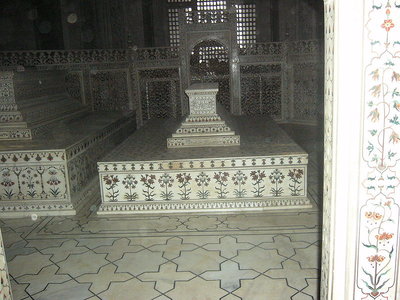
Choose one answer.
|
A. The Taj Mahal |
||
|
B. Humayun's Tomb |
||
|
C. The Jama Masjd of Dehli |
||
|
D. The Tomb of Salim Chisti |
||
|
E. The Moti Mosque |
Question 74
Fill in the blank. This image depicts the _____________ of Suleiman the Magnificent.
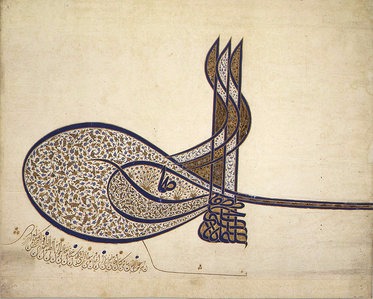
Choose one answer.
|
A. Tughra |
||
|
B. Nasta'liq |
||
|
C. Muraqqa |
||
|
D. Diwani |
||
|
E. Thuluth |
Question 75
This image depicts which early Mughal structure that was designed by a Persian architect yet includes Hindu domed pavilions surrounding the central dome?
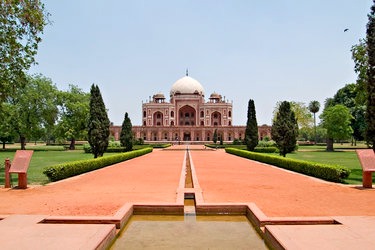
Choose one answer.
|
A. The Taj Mahal |
||
|
B. Humayun's Tomb |
||
|
C. The Jama Masjd of Dehli |
||
|
D. Lahore Fort |
||
|
E. The Babri Mosque |
Question 76
This image depicts which massive mosque that was commissioned by Shah Jahan?
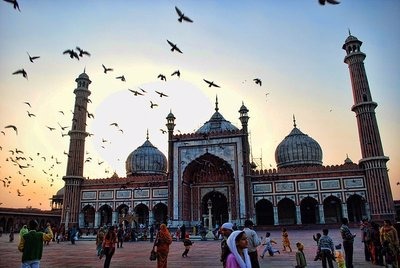
Choose one answer.
|
A. The Jama Masjid of Dehli |
||
|
B. The Mina Mosque |
||
|
C. The Moti Mosque |
||
|
D. The Babri Mosque |
||
|
E. The Gyanvapi Mosque |
Question 77
This image depicts which Ottoman mosque that incorporates elements of French empire style architecture?
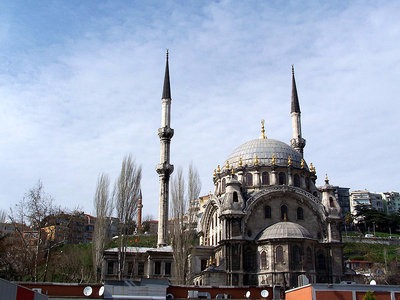
Choose one answer.
|
A. The Great Mosque of Córdoba |
||
|
B. The Nusretiye Mosque |
||
|
C. The Selimiye Mosque |
||
|
D. The Süleymaniye Mosque |
||
|
E. The Sultan Hasan Mosque |
Question 78
This image depicts which Ottoman palace? Its construction began directly after the Ottoman conquest of Constantinople.
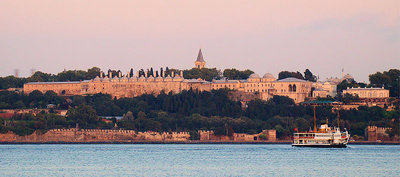
Choose one answer.
|
A. The Topkapi Palace |
||
|
B. Takht-i Sulayman |
||
|
C. Dolmabahçe Palace |
||
|
D. Yildiz Palace |
||
|
E. Hasht Behesht |
Question 79
This image depicts which Ottoman palace that is an example of neo-Baroque architecture?
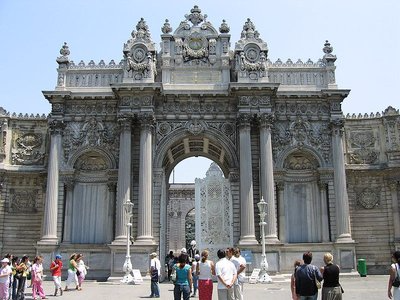
Choose one answer.
|
A. The Dolmabahçe Palace |
||
|
B. The Topkapi Palace |
||
|
C. Aynalıkavak Palace |
||
|
D. The Süleymaniye Palace |
||
|
E. The Yildiz Palace |
Question 80
This image depicts which structure that is part of Fatehpur Sikri? Originally made of red sandstone, its exterior was covered by white marble by Emperor Jahangir.
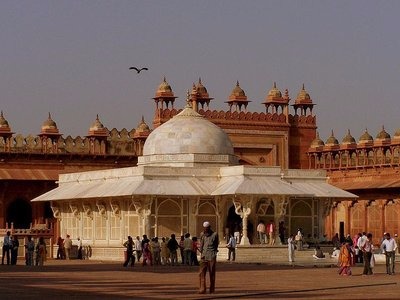
Choose one answer.
|
A. The Tomb of Salim Chisti |
||
|
B. The Jama Masjid of Dehli |
||
|
C. The Lahore Fort |
||
|
D. Humayun's Tomb |
||
|
E. The Moti Mosque |
Question 81
This image shows which mosque in Constantinople that was designed by the Ottoman architect Sinan?
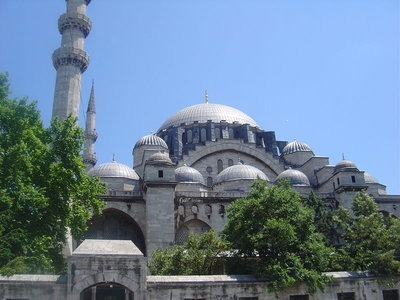
Choose one answer.
|
A. The Great Mosque of Córdoba |
||
|
B. The Sultan Hasan Mosque |
||
|
C. The Selimiye Mosque |
||
|
D. The Süleymaniye Mosque |
||
|
E. The Bibi Khanum Mosque |
Question 82
Turkish building projects in Constantinople focused upon what?
Choose one answer.
|
A. The development of complexes focused on a mosque that combined religious, funerary, educational, and financial institutions. |
||
|
B. The construction of a new city center that focused on the Ottoman Palace. |
||
|
C. The construction of a new city center that focused on the Hagia Sophia, which had been converted into a mosque. |
||
|
D. The construction of a city center focused on a large open courtyard surrounded by markets, mosques, and palaces. |
||
|
E. None of the above |
Question 83
Which nineteenth century Ottoman sultan's reforms brought about an increased fusion of Ottoman and European elements in Ottoman art and architecture?
Choose one answer.
|
A. Sultan Mahmud II |
||
|
B. Mustafa IV |
||
|
C. Suleiman the Magnificent |
||
|
D. Ahmed II |
||
|
E. Osman I |
Question 84
Which of the following characterize illuminated manuscripts made in the atelier of Jahangir?
Choose one answer.
|
A. Most were part of lavishly finished albums. |
||
|
B. They were usually created by a single painter. |
||
|
C. Many were plant and animal studies. |
||
|
D. Many contained realistic portraiture and Europeanized subjects. |
||
|
E. All of the above |
Question 85
Which of the following statements about the Taj Mahal is false?
Choose one answer.
|
A. It represents the Islamic garden of paradise. |
||
|
B. It is decorated with murals that depict Shah Jahan. |
||
|
C. It is decorated throughout with verses from the Koran. |
||
|
D. It contains the cenotaph of Mumtaz Muhal and Shah Jahan. |
||
|
E. All of the above |
Question 86
Which of the following statements about Ottoman mosques is false?
Choose one answer.
|
A. They are based on Seljuk and Byzantine architecture. |
||
|
B. They are distinguised by their dark interiors. |
||
|
C. They are based on a square dome plan. |
||
|
D. The mosque constructed by Sinan drew inspiration from the Hagia Sophia. |
||
|
E. They have slender corner minarets. |
Question 87
Which of the following statements about carpets in the Islamic world, c. 1600-1800, is false?
Choose one answer.
|
A. Carpet weaving was an important statewide industry in the Safavid, Ottoman, and Mughal empires. |
||
|
B. They were produced in large private factories. |
||
|
C. Carpets were traded with merchants from East Asia and Europe. |
||
|
D. Carpets were central to Shah 'Abbas I plan to attract foreign merchants. |
||
|
E. Few carpets were produced in India before the reign of Akbar. |
Question 88
Which of the following statements about Mughal architecture is false?
Choose one answer.
|
A. It combine local Hindu and Islamic building traditions with the architectural traditions of Iran and Central Asia. |
||
|
B. Early Mughal buildings were constructed from white marble. |
||
|
C. Mughal rulers commissioned many different types of buildings including palaces, mosques, gardens, and mausoleums. |
||
|
D. Mughal mosques have massive enclosed courtyards. |
||
|
E. Mughal mosques have domed shallow prayer halls. |
Question 89
Which of the following statements about Safavid architecture is false?
Choose one answer.
|
A. It continues Timurid and Persian architectural traditions. |
||
|
B. It does not use the four iwan plan. |
||
|
C. It includes elements such as pishtaqs. |
||
|
D. It uses brick and decorated tiles. |
||
|
E. It included massive city planning projects, such as those of Shah 'Abbas I. |
Question 90
Which of the following statements about the Shahnama of Shah Tahmasp is false?
Choose one answer.
|
A. It is written in nasta'liq script. |
||
|
B. Its fine paper is enriched with flecks of gold. |
||
|
C. It was created at the royal atelier at Tabriz. |
||
|
D. It was given as a gift to an Ottoman sultan. |
||
|
E. It was completed solely during the reign of Shah Tahmasp. |
Question 91
Which of the following statements about the Topkapi Palace is false?
Choose one answer.
|
A. It was built on the tip of the peninsula that overlooked the Golden Horn and the Bosphorous. |
||
|
B. It was surrounded by a wall and behind the wall were buildings loosely laid out in a garden like setting. |
||
|
C. The layout of the structure was not hierarchically ordered. |
||
|
D. It included residential, religious, educational, administrative, and service buildings. |
||
|
E. Its construction was ordered by Mehmed II, after he conquered Constantinople. |
Question 92
Which of the following statements is true of illuminated manuscripts in the Islamic world?
Choose one answer.
|
A. Many were created in non-royal commercial workshops. |
||
|
B. Illustrated books were financial investments, status symbols, and objects of diplomacy. |
||
|
C. Specific workshops produced copies of the Koran. |
||
|
D. The paper used for the books was made of tree pulp. |
||
|
E. Usually only one artist worked on each scene. |
Question 93
Which of the following statements is true of Ottoman architecture?
Choose one answer.
|
A. Early Ottoman architecture was based on Byzantine and Seljuk traditions. |
||
|
B. Ottoman architecture remained fairly uniform throughout its extensive empire. |
||
|
C. Imperial patronage focused on the construction of kulliye. |
||
|
D. All of the above |
||
|
E. None of the above |
Question 94
Which of the following statements is true of Shah 'Abbas I's building programs?
Choose one answer.
|
A. They consisted of an axial arrangement of new royal markets that linked the old city to a new center of markets, mosques, and the royal palace. |
||
|
B. Their new city center was comprised of a series of concentric circles. |
||
|
C. They did not make use of large open spaces but were comprised of a series of closely connected structures. |
||
|
D. They incorporated elements of the old city behind the gates of a massive citadel. |
||
|
E. All of the above |
Question 95
Which of the following structures was the royal palace built by Shah Jahan?
Choose one answer.
|
A. The Red Fort |
||
|
B. The Lahore Fort |
||
|
C. The Taj Mahal |
||
|
D. Fatehpur Sikri |
||
|
E. The Asfarwala Complex |
Question 96
Which of the following sultanates and/or empires were regular trading partners with the city of Venice?
Choose one answer.
|
A. Mamluk |
||
|
B. Safavid |
||
|
C. Ottoman |
||
|
D. All of the above |
||
|
E. None of the above |
Question 97
Which of the following was Russia's biggest import from the Ottoman and Safavid Empires?
Choose one answer.
|
A. Textiles |
||
|
B. Porcelain |
||
|
C. Enameled glass |
||
|
D. Jades |
||
|
E. Luster painted ceramics |
Question 98
Who commissioned the Taj Mahal?
Choose one answer.
|
A. Akbar |
||
|
B. Humayun |
||
|
C. Jahangir |
||
|
D. Shah Jahan |
||
|
E. Babur |
Question 99
Who was the first Mughal emperor to establish a royal atelier for the creation of illustrated manuscripts?
Choose one answer.
|
A. Akbar |
||
|
B. Humayun |
||
|
C. Jahangir |
||
|
D. Shah Jahan |
||
|
E. Babur |
Question 100
Who is one of the most famous Islamic architects that designed buildings throughout the Ottoman Empire, during the reign of Suleiman the Magnificent and Selim II?
Choose one answer.
|
A. Sinan |
||
|
B. Krikor Balyan |
||
|
C. Garabed |
||
|
D. Nikogos |
||
|
E. A. Jachmund |